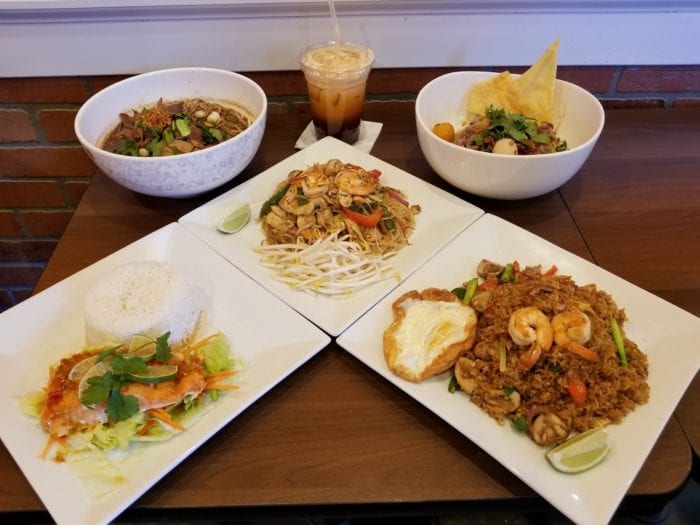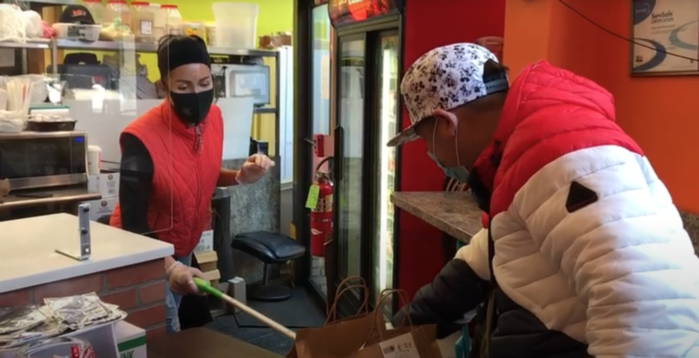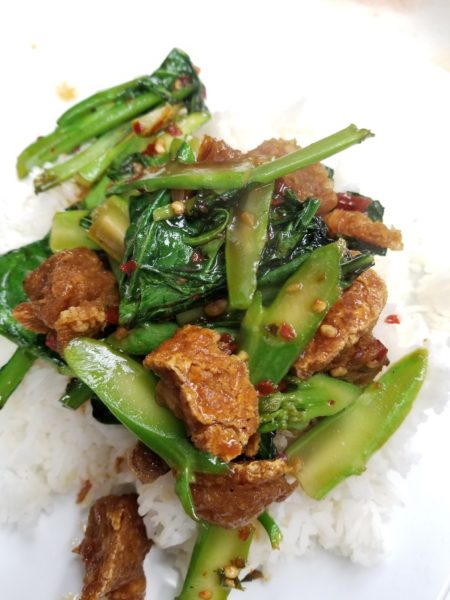
“They couldn’t make it authentic, so that’s why I make [my food] authentic for Thai people.”
Thai holy basil and Thai basil are not the same. They may both be green leaves and have similar names in English, but Thai people would know the difference. This is why when husband and wife Phannida (Ying) Panpeng and Pichai (Chai) Suppanisanuwong sell their pad krapow, or stir-fried Thai holy basil, at Pad Thai Cafe, they ship the plant in from China, Ecuador, or Florida.
“We have to have it in the restaurant no matter how expensive because if the people come and order Thai holy basil, I will have to use krapow and not the Thai basil leaf,” Suppanisanuwong said. “Sometimes, if we are short of it, I will tell the customer that we ran out of it and need to use Thai basil instead. Some people accept it, but others will say, “OK, I will come in next time [when you have it].’”
Pad Thai Cafe in downtown Boston prides itself on authenticity and not altering their food to fit an American audience. Whether it is pig blood soup (kuay tiaw rua) or fluffy fried catfish (yum pla dook fu), the food tastes the same as when I grew up ordering street food from vendors in Thailand.

“A long time ago when I worked at a restaurant, all of the Americans didn’t know a lot about authentic Thai food because the [restaurants would] just cook for Americans,” Suppanisanuwong said. “While some customers like that [kind of food], they don’t know the real Thai authentic taste. For me, I could not go out and eat in Thai restaurants because they couldn’t make it authentic, so that’s why I make [my food] authentic for Thai people.”
The restaurant is located in Fenway, a prime spot for their business as it is easily accessible for nearby students from Berklee College of Music, Boston University, and Northeastern University. Panpeng said the majority of their customers are Thai students and tourists, which gives them the ability to continue cooking the traditional dishes.
“I can give the Americans a trick: If a Thai restaurant has a lot of Asian people eating there, then the restaurant has to be authentic,” Suppanisanuwong said.
Suppanisanuwong grew up in Saraburi, a province in central Thailand, while Panpeng grew up in Phetchabun, which is located in the north. Within the four regions of Thailand (Central, Northern, Northeastern or Isan, and Southern) the common flavors and dishes shift, largely due to the influence of local ethnic groups and immigrants. For example, khao soi—which is offered at Pad Thai Cafe—is a Northern Thai curry noodle soup with coconut milk that many Thai people attribute to the influence of Yunnanese Muslims and Shan food.
Panpeng said that because she and her husband are from Northern and Central Thailand, their food would be less spicy than Southern Thai cooking.
Suppanisanuwong learned how to cook Thai food from his family members, many of whom own their own restaurants in Thailand and in the United States.
“Everything that I learned is from my mom and if I have any questions or struggle with my food, I still ask my mom,” Suppanisanuwong said.
 Suppanisanuwong and Panpeng both originally came to the US to attend university. They met in 2001 while working at another Thai restaurant in Boston named Sweet Chili where he waited on tables and she was a hostess.
Suppanisanuwong and Panpeng both originally came to the US to attend university. They met in 2001 while working at another Thai restaurant in Boston named Sweet Chili where he waited on tables and she was a hostess.
A year later, they got married and started their own restaurant in Arlington called Lady Siam, which they sold with the intention of moving back to Thailand together—until Panpeng realized she was pregnant. They decided to stay in the US instead and opened Pad Thai Cafe shortly after in 2017.
They now both balance running the restaurant and taking care of their daughter, who is three and a half years old, and their son, who is one.
“In the morning, I have to prepare food for the day and so I go to the restaurant and buy groceries, everything!” Panpeng said. “And every Friday I have to go shopping for the restaurant for almost the entire day.”
Due to the COVID-19 pandemic, Panpeng said they have seen a decrease in their usual customers as schools shut down and fewer Thai tourists enter the country. The restaurant had to close down all in-person dining options and move all ordering to pickup or delivery because the space is too small for social distancing and table dividers were too expensive. This has put stress onto their restaurant as American customers are not a large part of their business.
Thai cuisine is known for being a medley of the five flavors: spicy, sour, sweet, bitter, and salty. The concern of cooking authentic dishes is that American customers would not be able to handle the strong flavors and therefore the restaurant wouldn’t receive any business.
Suppanisanuwong said some people love trying the new delicious flavors, while others push back when they can not relate it to the Americanized Thai food they had previously experienced.
“[Traditional] pad thai is brown and a little bit burnt so you can taste the wok,” Suppanisanuwong said. “But if [American] customers have had pad thai before at an American restaurant that is their favorite where it is made really stocky, then they will say that my pad thai is burnt. There is no right or wrong, but I cook it the authentic way.”
This does not mean, however, that the food from Pad Thai Cafe is made one way and one way only. Suppanisanuwong said the main goal is to find the best dish for the customer and that he often will have conversations with people about the flavors they are interested in, the spice level they can handle, and other details about their personal preferences.
“Sometimes people will come to the restaurant and show a picture and ask if we know what it is,” Suppanisanuwong said. “I say OK. If the picture is clear and I know some of the information of how it tastes, I will cook it for you outside of the menu.”
This echoes traditional Thai values as it is common for Thai people to tell cooks about their preferences. For example, with papaya salad—a dish also served at Pad Thai Cafe—Thai people usually tell the chef how many chilis they can handle and if they like the flavors to be more sweet or sour.
Panpeng said the main cultural difference she sees from selling to American customers compared to Thai is how relaxed Thai people are. The Thai language itself has a multitude of phrases that roughly translate to “It’s all right!” or “No worries!”
“Thai culture is just easy, you know?” Panpeng said. “I think the American customers just love the way that we do this in the restaurant.”
